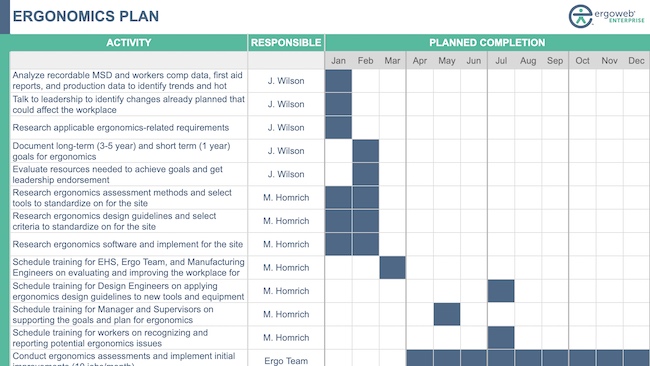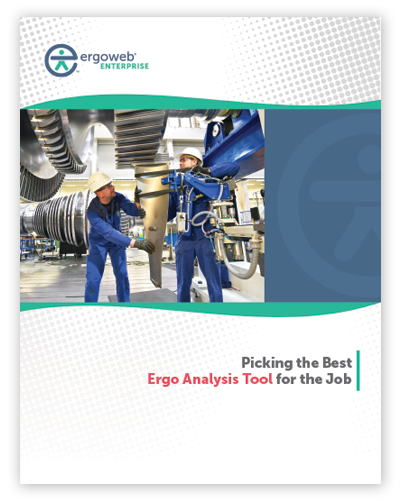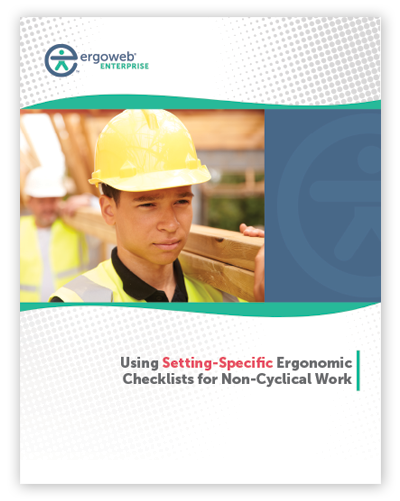Ergoweb® Learning Center
We’ve published and shared thousands of ergonomics articles and resources since 1993. Search by keyword or browse for topics of interest.
Downloadable Guides
Open Access Articles
December 3, 2012
University of Michigan based researchers Neal Wiggermann and W. Monroe Keyserling conducted an experiment to investigate the effects of "anti-fatigue" mating on the perceived discomfort and weight shifting during prolonged standing. Their results are of great interest to ergonomists and employers seeking to reduce discomfort related to long duration standing. This article reviews the state-of-the-art understanding of the relationship between floor surface and standing discomfort and concludes with applicable recommendations for selecting anti-fatigue mats.
November 30, 2012
In this reprint from The Ergonomics Report, Gene Kay and Peter Budnick review a research article summarizing the findings of a team of researchers from India that performed a study looking at various associations between body mass index BMI, musculoskeletal discomfort, and occupational stress among computer workers. Their results add to the growing understanding that being overweight can have a significant effect on musculoskeletal discomfort and occupational stress measures.
November 27, 2012
In a broad sense, ergonomics is as old as humankind, or at least some point long ago in human history. Many trace its origins to that day when the first human realized that a sharp rock or a pointy stick was useful as a tool. Whoever it was, whenever it was, found a way to improve upon human capabilities by creating a tool. Peter Budnick traces those humble beginnings forward, highlighting key developments through history that have lead to what we recognize today as Ergonomics ... or Human Factors ... or whatever it is we do ... or whatever it is we call it ...
November 14, 2012
Join us March 18-21 in Dallas for one of the most highly anticipated ergonomics and human factors events of the year. It
November 14, 2012
In 1857 -- over 150 years ago -- a Polish scholar named Wojciech Jastrzebowski coined the word "ergonomics". Have we made any progress since? In this fun and interesting reprint from the September 2002 edition of the Ergonomics Report, we ask, "You be the judge".
November 8, 2012
Ergonomics In Design has published a special issue on the Globalization of Ergonomics, and you can get free access to it through the end of November 2012! This special issue includes a feature by Ergoweb's Peter Budnick and co-authors Kazutaka Kogi and David O'Neill titled "Examples of Practical Ergonomics in Industrially Developing Countries." Features by Thomas J. Smith, R. S. Bridger, David C. Caple, Nancy L. J. Larson, Halimahtun M. Khalid and Martin G. Helander, and Candice Jo-Anne Christie are also included.
November 7, 2012
Peter Budnick reviews a fascinating article describing and analyzing newly rediscovered archives from the original Hawthorne experiments that took place in the late 1920's. The experiments were intended to demonstrate that better lighting would improve industrial productivity, but a variety of factors produced unexpected results, and the original data was thought to be destroyed in the aftermath. The so called Hawthorne Effect has been a subject of debate and speculation ever since and has influenced scientific methods and the fields of psychology, education, social sciences -- and ergonomics. Cornell researchers Izawa, French and Hedge share their findings.
November 1, 2012
There's been a lot of talk lately about ergonomic product certification, and Peter Budnick takes readers on a tour of the topic, drawing from work he's done on the question over the last 10-15 years. In this article, Part 1 in a series, he shares insightful video of interviews he conducted with consumers on the questions of "what does ergonomics mean" and "what would an 'ergonomically designed' label mean to you?" He also shares examples of how other industries have developed certifications, why industries need credible certification systems, and how that might come about for the field of ergonomics.
October 31, 2012
Ergoweb's Peter Budnick shares his anger with what he sees as "abusive design," using the incomprehensible interface of an AT&T telephone his aging parents purchased as an example. Quoting Jack Rebney, a man described as "The Angriest Man in the World," he launches his controlled tirade with the phrase "I wonder how you're going to feel about this when you're [swear word deleted] 80 years old." He describes the conditions under which abusive designs make it to market, as well as the conditions that lead to usable customer-centered designs by drawing parallels with Lean organizational methods, and closes with an open-ended call for change.






